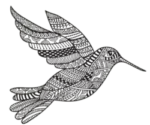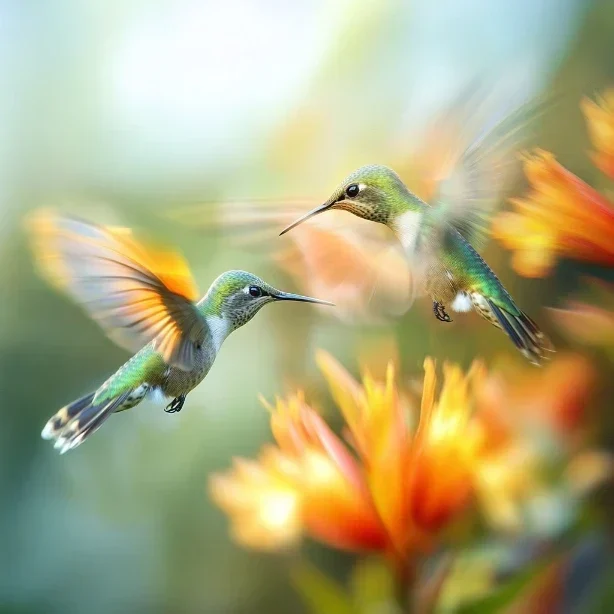(Or: How to Freeze Time with a Camera and Endless Patience)
In the world of wildlife photography, capturing a hummingbird in flight is like trying to photograph a living bullet that’s having a really caffeinated day. These tiny speed demons have pushed the boundaries of photographic technology, forcing photographers and scientists alike to develop increasingly sophisticated methods to document their extraordinary behaviors.
Let’s start with some numbers that make professional photographers reach for their fastest memory cards:
- Wingbeats too fast for human eyes to track
- Movement speeds that blur most camera settings
- Light requirements that challenge conventional photography
- Behavior patterns that test photographer patience
- Equipment demands that make wallet-conscious photographers weep
The Technical Challenge
Photographing hummingbirds is like trying to capture lightning in a bottle, except the lightning is wearing feathers and has an attitude. Modern camera technology has finally caught up with these aerial acrobats, but mastering the art requires understanding some fundamental challenges.
Essential camera requirements include:
- Shutter speeds of at least 1/4000th second
- High-speed sync flash capabilities
- Ultra-fast autofocus systems
- Excellent low-light performance
- Memory cards that can keep up with burst shooting
The High-Speed Revolution
The advent of high-speed photography has transformed our understanding of hummingbird behavior. What once appeared as a blur of wings has become a precise ballet of aerodynamic mastery, revealed frame by frame through the magic of modern technology.
High-speed capture techniques include:
- Multiple flash systems firing in sequence
- Specialized trigger mechanisms
- Advanced motion sensors
- Computer-controlled timing systems
- What amounts to a miniature lightning storm in your backyard
The Setup Secrets
Creating the perfect hummingbird photo studio requires more planning than a military operation and more patience than teaching calculus to cats. The result, however, can be absolutely magical.
Essential setup elements include:
- Multiple flashes positioned strategically
- Carefully placed feeders or flowers
- Background considerations
- Wind protection systems
- Camouflage or blind setups
The Lighting Dance
Light is both friend and foe when photographing hummingbirds. Too much washes out their iridescent colors; too little leaves you with nothing but exotic blurs.
Lighting considerations include:
- Flash duration versus ambient light
- Color temperature management
- Multiple flash synchronization
- Natural light integration
- The eternal battle against harsh shadows
The Focus Challenge
Focusing on a hummingbird is like trying to thread a needle while riding a motorcycle. These tiny speedsters require specialized techniques and often a healthy dose of luck.
Focus strategies include:
- Pre-focus on favorite perches
- Advanced tracking systems
- Zone focusing techniques
- Depth of field management
- What sometimes feels like telepathic prediction
The Post-Processing Magic
Even the perfect capture often needs some digital finesse to reveal the true magic of hummingbird flight. Modern post-processing has opened new doors in hummingbird photography.
Post-processing techniques include:
- High-speed sequence compilation
- Color enhancement for iridescence
- Motion blur management
- Detail recovery in shadows
- The digital equivalent of time manipulation
The Scientific Value
Beyond their artistic merit, high-speed hummingbird photographs have revolutionized our understanding of these remarkable creatures.
Research applications include:
- Flight mechanics analysis
- Behavior documentation
- Wing movement studies
- Feeding pattern research
- Courtship ritual documentation
The Equipment Arsenal
Capturing hummingbirds requires a specialized set of tools that would make James Bond’s Q Branch proud.
Essential gear includes:
- High-speed capable cameras
- Multiple flash units
- Specialized triggers
- Weather protection
- The photographer’s equivalent of a NASA control center
The Patience Game
Perhaps the most crucial element in hummingbird photography isn’t technical at all – it’s the ability to wait, and wait, and wait some more.
Patience requirements include:
- Hours of motionless observation
- Countless failed attempts
- Weather delays
- Equipment adjustments
- What feels like years off your life
The Environmental Factors
Mother Nature rarely cooperates with photographers’ plans, especially when hummingbirds are involved.
Environmental challenges include:
- Wind management
- Light variation
- Weather protection
- Temperature considerations
- The eternal battle against Murphy’s Law
Conclusion: Freezing Time’s Fastest Flyers
Successfully photographing hummingbirds represents one of the most challenging yet rewarding pursuits in wildlife photography. Each captured image freezes a moment that the human eye can never perceive in real-time, revealing the extraordinary beauty and complexity of these remarkable birds.
Remember: The next time you see a perfect hummingbird photograph, you’re looking at the result of countless hours of preparation, technical expertise, and probably more than a few muttered prayers to the photography gods.
Post Script: Some photographers suspect hummingbirds can see camera sensors warming up and deliberately avoid them. The birds aren’t commenting, but their perfectly timed exits from frame suggest they might be in on the joke.


